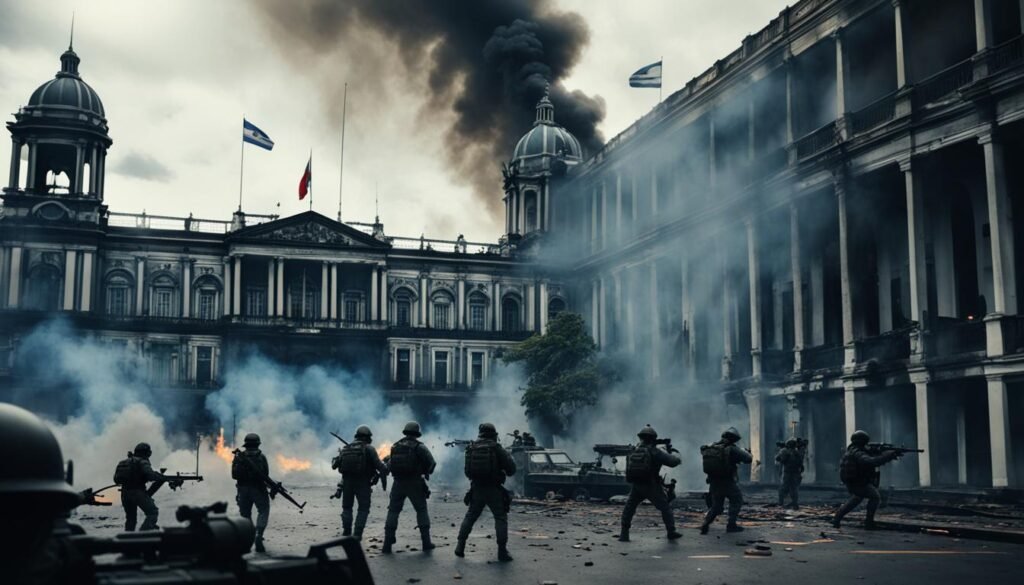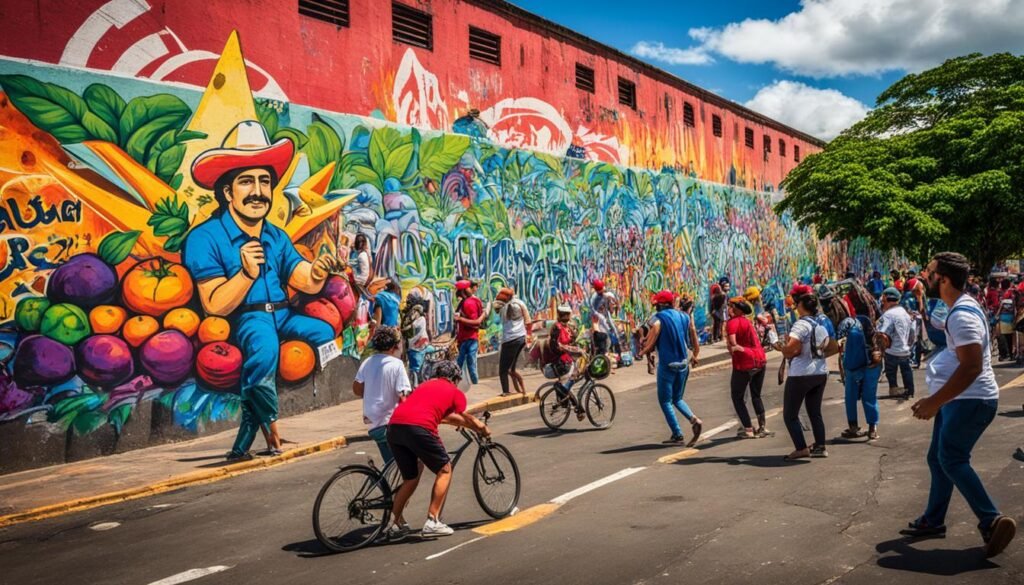Over 50,000 people lost their lives during the Nicaraguan Revolution, a pivotal conflict that reshaped the political landscape of Central America in the late 20th century. This revolutionary struggle, sparked by growing opposition to the long-standing Somoza dictatorship, ultimately led to the overthrow of the regime in 1978-79. The revolution’s impact reverberated far beyond Nicaragua’s borders, as the nation became a key battleground in the larger Cold War proxy war between the United States and the Soviet Union.
Key Takeaways
- The Nicaraguan Revolution was a pivotal conflict that led to the overthrow of the Somoza dictatorship in 1978-79.
- The revolution was inspired by the successful Cuban revolution of 1959 and was led by the Sandinista National Liberation Front (FSLN).
- The revolution became a key battleground in the Cold War, with the United States and Soviet Union backing opposing sides.
- The revolution’s aftermath included a prolonged civil war between the Sandinista government and the Contra rebel movement.
- The Nicaraguan Revolution had a lasting impact on the political and social landscape of Central America.
Background: The Somoza Dynasty
For over four decades, the Somoza family’s political dynasty firmly ruled Nicaragua. This era was marked by both economic development and rising inequality, as well as strong U.S. support for the government and its military. The Somoza family’s iron grip on power was built upon a foundation of political corruption and the ruthless suppression of dissent.
The Somoza Family’s Iron Grip on Nicaragua
In 1927, the U.S. government formed a pact with Nicaragua to supervise elections and establish a National Guard, which they placed under the command of Anastasio Somoza García. This move would prove pivotal, as Somoza later used his position to seize the presidency through fraudulent elections. His son, Luis Somoza Debayle, and grandson, Anastasio Somoza Debayle, would continue the family’s authoritarian rule in the years that followed.
U.S. Intervention and the Banana Wars
The U.S. effectively chose the president of Nicaragua in exchange for loans to the government, and the military occupation remained in effect for the most part until 1933. This period, known as the “Banana Wars,” saw the U.S. intervene in various Central American countries to protect its economic interests, particularly in the banana industry. The Somoza regime benefited from this U.S. support, further entrenching its power and stifling any attempts at democratic reform.

Birth of the Sandinista National Liberation Front
In 1961, a group of student activists at the Universidad Nacional Autonoma de Nicaragua (UNAN) in Managua founded the Sandinista National Liberation Front (FSLN). The movement was inspired by the success of the Cuban revolution in 1959 and shared its vision of land reform, universal education, and anti-American sentiment. The FSLN took its name from Nicaraguan hero Augusto Sandino, who led a guerrilla campaign against the U.S. occupation in the 1920s and 1930s.
The FSLN was spearheaded by Carlos Fonseca Amador, Silvio Mayorga, and Tomás Borge Martínez, who sought to overthrow the long-standing Somoza dictatorship. In the early 1970s, the FSLN gained significant momentum, launching a military campaign against the regime and employing guerrilla tactics. The group received support from Cuba, Panama, and Venezuela, further strengthening its resolve to challenge the Somoza family’s iron grip on Nicaragua.

The birth of the Sandinista National Liberation Front marked a pivotal moment in Nicaragua’s history, as the country’s youth mobilized to resist the oppressive Somoza dynasty and inspire a broader revolution inspired by the Cuban model. This grassroots movement would soon reshape the political landscape of Central America, setting the stage for a momentous clash between the Sandinistas and the Somoza regime.
Key Events of the Nicaraguan Revolution
The 1970s marked a pivotal period in the Nicaraguan Revolution, as the Sandinista National Liberation Front (FSLN) intensified its campaign against the authoritarian Somoza regime. The FSLN’s tactics included a series of high-profile kidnappings, which thrust the group into the national spotlight and solidified its reputation as a formidable force.
The Assassination of Pedro Joaquín Chamorro Cardenal
One of the most significant events was the assassination of Pedro Joaquín Chamorro Cardenal, a prominent opposition newspaper editor, in 1978. Chamorro’s murder at the hands of the Somoza regime’s National Guard sparked outrage among Nicaraguans and drove many to join the Sandinista movement, further fueling the revolutionary fervor.
The National Palace Siege
In 1978, the FSLN staged a bold and dramatic hostage-taking operation, seizing control of the National Palace and taking nearly 2,000 hostages. The group demanded the release of Sandinista prisoners, significant financial compensation, and widespread media coverage to amplify their cause. This high-profile event attracted international attention and heightened the pressure on the Somoza regime, which was increasingly seen as a brutal and repressive force by the global community.

The FSLN’s strategic use of kidnappings, assassinations, and high-stakes hostage crises ultimately contributed to the erosion of the Somoza regime’s legitimacy and its eventual downfall, paving the way for the Sandinistas’ rise to power in the Nicaraguan Revolution.
Nicaragua: Central American Revolution History Managua Nicaragua
The Nicaraguan Revolution unfolded in the capital city of Managua, where the Somoza regime had its stronghold. The Sandinista guerrillas surrounded Managua in 1979, leading to the resignation and flight of dictator Anastasio Somoza. This pivotal moment solidified the Sandinista’s control over Nicaragua and marked the end of the Somoza dynasty that had ruled the country for over four decades.
With the Sandinistas in power in Managua, they quickly moved to implement their revolutionary agenda. This included sweeping land reform policies that were unpopular with the upper middle class, wealthy, and many working professionals who subsequently immigrated to the United States. The Sandinista victory in Managua was a crucial turning point in the broader Central American revolution, prompting a U.S. intervention through the Contra war to try and undermine the new Nicaraguan government.

The streets of Managua were the backdrop for much of the conflict between the Sandinista guerrillas and the forces of the Somoza regime. The Sandinista’s siege of Managua in 1979 was a strategic masterstroke that forced Somoza’s resignation and paved the way for their takeover of the capital and the country. This solidified the Sandinista revolution and its lasting impact on Nicaragua and the wider Central American region.
The Fall of Somoza and Rise of the Sandinistas
In 1979, the Somoza regime in Nicaragua finally collapsed after decades of authoritarian rule. With support from Cuba and the Soviet Union, the Sandinista guerrilla soldiers surrounded the capital city of Managua, forcing the dictator Anastasio Somoza to resign and flee the country. The Sandinistas then installed their own government, ushering in a new era for Nicaragua.
Sandinista Tactics and Guerrilla Warfare
The Sandinistas had employed effective guerrilla warfare tactics, inspired by the Cuban revolution and figures like Che Guevara, to overthrow the Somoza regime. Their successful strategy involved mobilizing the masses, conducting urban insurrections, and launching coordinated attacks against the Somoza forces. This guerrilla approach proved crucial in toppling the long-entrenched Somoza dynasty.
Once in power, the Sandinista government immediately began implementing land reform policies, which were unpopular with the upper middle class, the wealthy, and many working professionals who immigrated to the United States. However, not all Nicaraguans were content with Sandinista rule, and a new counterrevolutionary movement, the Contras, emerged to oppose the Sandinista government.
The Sandinista victory marked a significant turning point in Nicaragua’s history, ushering in a new era of political and social transformation. The Somoza regime, which had long dominated the country, was finally toppled, paving the way for the Sandinistas to implement their revolutionary agenda and reshape the political landscape of Central America.
The Contra War and U.S. Intervention
When Ronald Reagan became president in 1981, his administration made it a priority to assist the Contras, a group of right-wing rebels fighting against the leftist Sandinista government in Nicaragua. However, in 1982, Congress passed the Boland Amendment, which prohibited the federal government from providing aid to the Contras for the purpose of overthrowing the Nicaraguan government, effectively tying Reagan’s hands.
Suspicion grew throughout the 1980s that the Reagan administration and the CIA were covertly aiding the Contras, despite the Boland Amendment. This suspicion was realized in the Iran-Contra Affair in 1986, where the U.S. had secretly sold weapons to Iran in exchange for the release of U.S. hostages, and had then funneled a portion of the profits to the Contras. This scandal highlighted the tensions between the executive branch and Congress over U.S. intervention in Nicaragua.
The Boland Amendment and Iran-Contra Affair
The Boland Amendment and the subsequent Iran-Contra Affair played a significant role in the Contra War and U.S. intervention in Nicaragua. The Reagan administration’s efforts to circumvent the Boland Amendment and provide aid to the Contras underscored the deep divisions over the appropriate level of U.S. involvement in the region.
Elections and Power Transitions
The Sandinista party’s rise to power in Nicaragua was marked by a series of contested electoral victories. After the fall of the Somoza dynasty, the Sandinistas began holding elections, though the fairness of these polls was often disputed. In the 1984 election, Sandinista leader Daniel Ortega won the presidential race, and the party remained in power until 1990.
In that year, an opposing party defeated the Sandinistas at the ballot box, ending their decade-long rule. However, the Sandinistas remained a powerful political force in Nicaragua. Ortega, in particular, continued to play a prominent role, and in 2006 he was re-elected as president, a position he holds to this day.
Ortega’s return to power has been controversial, with his administration accused of democratic backsliding and human rights abuses. This has led to a steady stream of Nicaraguans fleeing the country and immigrating to the United States, seeking refuge from the Sandinista regime’s increasingly authoritarian tendencies.
The complex political history of Nicaragua, marked by the rise and fall of the Sandinista party’s electoral victories and power transitions, continues to shape the country’s future and its relationship with the international community.
Lasting Impact of the Nicaraguan Revolution
The Nicaraguan Revolution has left an indelible mark on the country and the Central American region. The initial Sandinista uprising against the oppressive Somoza dynasty and the subsequent Contra war against the Sandinista government have created a legacy of political instability and violence in Nicaragua.
The Sandinista movement, led by the iconic figure of Daniel Ortega, has remained a dominant force in Nicaraguan politics, even as the country has experienced transitions of power. The Ortega regime’s authoritarian tendencies and crackdowns on political dissent have further contributed to the ongoing political instability in the country.
The U.S. intervention in the Contra war and the Iran-Contra Affair have also had far-reaching consequences, both for Nicaragua and for American foreign policy. The Nicaraguan Revolution has become a pivotal event in the history of Central American conflicts and the broader Cold War, with its impact still felt today.
Despite the challenges and setbacks, the Nicaraguan Revolution remains a symbol of resistance and self-determination for many in the region. Its legacy continues to shape the political landscape of Nicaragua and serves as a cautionary tale of the consequences of foreign intervention and the pursuit of power.
Conclusion
The Nicaraguan Revolution stands as a pivotal moment in Central American history, revealing Nicaragua as a major proxy war battleground during the Cold War era. The revolution began with the rising opposition to the Somoza dictatorship in the 1960s and 1970s, leading to the ouster of the regime in 1978-79 and the subsequent Contra War that lasted until 1990. The Sandinista National Liberation Front, inspired by the Cuban revolution, played a central role in the overthrow of the Somoza government and the installation of their own leftist regime.
However, this led to a prolonged civil war with the Contra rebels, who were supported by the Reagan administration. The lasting impact of the Nicaraguan Revolution can be seen in the country’s continued political instability, the enduring influence of the Sandinista movement, and the broader implications of U.S. intervention in Central American conflicts during the Cold War era. The Nicaraguan Revolution has left an indelible mark on the region, shaping the political and social landscape for decades to come.
As the Nicaraguan Revolution fades into history, its legacy serves as a cautionary tale of the dangers of foreign intervention and the complex dynamics of political change in Central America. The lessons learned from this pivotal conflict continue to resonate, informing our understanding of the Nicaraguan Revolution’s lasting impact on the region and its people.
Source Links
- Milestones in the History of U.S. Foreign Relations – https://history.state.gov/milestones/1977-1980/central-america-carter
- NewsHour Coverage of the Hot Wars of the Cold War – https://americanarchive.org/exhibits/newshour-cold-war/nicaragua
- Nicaraguan Revolution – https://en.wikipedia.org/wiki/Nicaraguan_Revolution


